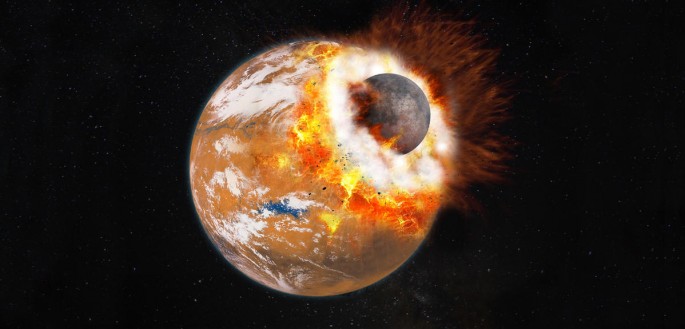Scientists now investigate the origins of the moons of Mars, Phobos and Deimos that has been an enigma for many years. Now, two new studies claim that these Martian moons are made from a colossal collision during the Red Planet's early days.
In a new study by an international team of scientists, new findings have determined these Martian lunar origins where they are created from debris during a time Mars was still a protoplanet, about a third of its current size today. This collision occurred some 100 to 800 million years ago as Mars was evolving into a planet.
This debris first appeared as material orbiting the protoplanet within a very wide disk. The inner part of the ring was created from fusion of the matter around it as the outer ring was composed of a tenuous layer of gas.
Within the inner ring, a moon was initially created which is estimated to be more than a thousand times larger than Phobos, which disappeared during the evolution of Mars. Due to gravitational forces between the outer gas layers and a star, these apparently triggered the formations of smaller moons after.
After a few thousand years, there were only 10 small moons and a large moon that was orbiting Mars, however, this debris disk disappeared eventually after a few million years. With the help of Martian tidal forces, the moons including the largest satellite were reeled in towards the surface of Mars, where Phobos and Deimos remained in orbit.
However, scientists from the French National Centre for Scientific Research and the Marseille Université challenge this theory of Martian moons smashing onto the surface of Mars due to tidal forces. Their findings reveal that light signatures from the remaining two moons are not similar to the ones found on the surface of Mars.
In both studies, evidence points to how these Martian moons were still created during a collision with another large cosmic object. Scientists also suggest how these moons were composed of dust and particles that originate from gas condensation in the outer disk where a dust particle measures less than a single micrometer.
Apart from this, this violent and massive collision could also hold clues why there is a significant difference between the altitudes of the northern and southern hemispheres on Mars. Scientists also suggest that the Borealis basin located in the northern hemisphere is the actual site of this cosmic collision, which may have also affected the rotational velocity of Mars, which is six times slower than Earth's.
These new findings are published in the journal Nature Geoscience.



























